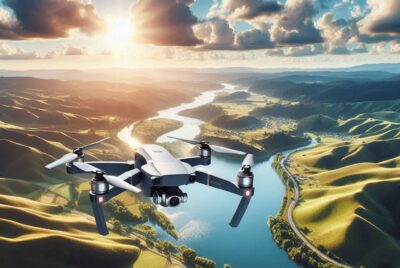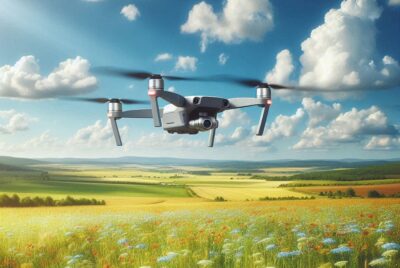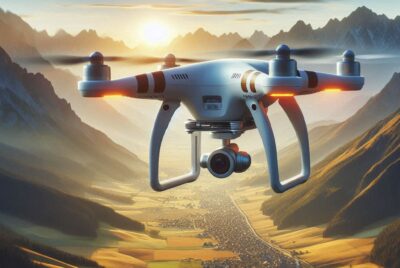Drone Safety: Navigating the Skies Responsibly
*We may earn a commission for purchases made using our links. Please see our disclosure to learn more.
Drone Safety Essentials: Your Guide to Secure Flights
Drone safety is an essential aspect of operating unmanned aircraft systems, commonly referred to as drones. My understanding of the subject is informed by regulations and guidelines set forth by the Federal Aviation Administration (FAA) and personal experience in the field. Safety is not only a personal responsibility but also a legal requirement when it comes to drone operation. It involves understanding the rules and guidelines for flying drones, whether for recreational, commercial, or public safety purposes.
I appreciate the importance of registering drones with the FAA and obtaining the appropriate certifications, such as the Part 107 certificate for non-recreational drone pilots. For leisure enthusiasts, passing The Recreational UAS Safety Test (TRUST) is a standard requirement. Knowing these procedures ensures that I adhere to the law while maximizing the potential of my drone operations.
Public safety is a prime consideration when I fly my drone. I make sure to stay updated with the latest FAA rules, such as the remote identification of drones and the conditions under which small drones may fly over people and at night. These rules not only serve to secure the airspace but also protect people on the ground. In my flights, I aim to integrate drones into our national airspace system carefully and considerately, maintaining mindfulness of the safety of other airspace users and individuals within my drone’s operating area.
Drone Safety Fundamentals

In this section, I’ll guide you through the key pillars of drone safety, which are critical to operating unmanned aircraft within the regulations set by the Federal Aviation Administration (FAA). I’ll cover not only the basics of the national airspace system but also registration requirements and the importance of Remote ID for safety.
Understanding the National Airspace System
I need to emphasize that whenever I fly a drone, I’m sharing the skies with other aircraft. The National Airspace System (NAS) is a complex network of airways, navigational services, and airports managed by the FAA. Familiarity with the NAS is imperative for safe drone operation. The FAA divides the airspace into different classes, with specific rules for each.
- Class A: Generally from 18,000 feet mean sea level (MSL) up to and including flight level (FL) 600 (including the airspace overlying the waters within 12 nautical miles off the coast of the 48 contiguous states and Alaska).
- Class B: Generally, from the surface to 10,000 feet MSL surrounding the nation’s busiest airports in terms of airport operations or passenger traffic.
- Class C: Generally, from the surface to 4,000 feet above the airport elevation (charted in MSL) surrounding those airports that have an operational control tower, are serviced by radar approach control, and that have a certain number of IFR operations or passenger enplanements.
- Class D: Generally, from the surface up to 2,500 feet above the airport elevation (charted in MSL) surrounding those airports that have an operational control tower.
- Class E: All other controlled airspace not classified as Class A, B, C, or D.
As a drone operator, I must adhere to the specific regulations that apply to the class of airspace in which I am flying.
FAA Registration Requirements
Before I can legally launch my drone into the skies, I must ensure it’s registered with the FAA. This requirement applies to all unmanned aircraft weighing more than 0.55 pounds (250 grams) and less than 55 pounds. The registration process involves marking my drone with a unique identifier and understanding my responsibilities as a pilot, such as staying below 400 feet in uncontrolled airspace and never flying over groups of people.
The Role of Remote ID in Drone Safety
Remote ID acts as a digital license plate for drones, providing identification and location information about the drone and its control station. It’s a step by the FAA to integrate drones safely into the NAS by ensuring other airspace users and law enforcement can ascertain the identity of a drone flying nearby. This feature becomes increasingly crucial as more drones take to the skies. According to the law, I must outfit my drone with Remote ID or operate within the visual line of sight in designated areas established by the FAA.
Operating Guidelines for Safe Drone Flight

When I fly my drone, my top priority is safety. By following specific guidelines, I ensure compliance with FAA rules and minimize risks in the airspace. Let’s dive into the essentials for operating drones responsibly.
Adhering to FAA Rules and Regulations
The FAA treats drones as part of the national airspace system. I make sure to abide by regulations which state that for recreational flying, I must pass The Recreational UAS Safety Test (TRUST) and follow the safety guidelines established by the FAA. This includes registering my drone if it weighs more than 0.55 pounds. Commercial drone pilots must follow Part 107 regulations, which include passing an aeronautical knowledge test.
Flying Within Visual Line of Sight
Maintaining a visual line of sight with my drone at all times is critical. It means I must keep my drone close enough to see it without the assistance of any devices other than corrective lenses. This is crucial in both controlled and uncontrolled airspace. By doing so, I can ensure safe operation and immediate action if I encounter any potential hazards.
Utilizing LAANC for Airspace Authorization
For access to controlled airspace, I use the Low Altitude Authorization and Notification Capability (LAANC) to receive near real-time authorization. The LAANC is a collaboration between the FAA and private industry to facilitate safe airspace integration by providing drone pilots with access to controlled airspace at or below 400 feet. Using LAANC helps me plan my drone flights with the knowledge that I have the proper clearance, especially in areas where manned aircraft operate.
Drone Safety – Advancing Drone Pilot Proficiency
Accurate piloting and comprehensive knowledge of regulations are vital for drone pilots. Whether one is flying drones for recreation or commercial purposes, mastering the relevant examinations is a critical step towards ensuring safety and proficiency.

Studying for Recreational UAS Safety Test
As a drone pilot, the Recreational UAS Safety Test (TRUST) represents my foundational step towards responsible flight. Adherence to FAA guidelines for safety is not just about compliance; it’s about understanding the airspace and how my drone interacts with it. I prepare for this test by studying educational materials provided by the FAA that focus on areas such as aeronautical knowledge, regulations, and operational procedures. Passing this test demonstrates my commitment to safety and my acknowledgment of the recreational requirements set by the aviation authority.
Becoming a Certificated Remote Pilot for Commercial Use
For commercial operations, becoming a Certificated Remote Pilot involves stringent preparation and passing the Part 107 test, which is a more comprehensive examination requiring in-depth understanding of FAA guidelines. Below is a structured approach I take to ensure readiness:
- Comprehend FAA Regulations: Key to piloting drones professionally.
- Aeronautical Knowledge: Develop this through official FAA training materials.
- Flight Proficiency: Practice regularly to manage various flight conditions.
My education comprises both theoretical and practical elements, ensuring that pilot proficiency goes beyond book knowledge. When I am certified, it signifies not only my ability to fly drones safely but also my preparedness to contribute to the evolving standards of remote pilot competence, maximizing safety in public and commercial airspace.
Drone Maintenance and Drone Safety Features
As a drone enthusiast, I know that proper maintenance and understanding the safety features of my drone are critical to safe flight operations. Routine checks and familiarity with my drone’s capabilities can prevent accidents and extend the lifespan of the equipment.
Conducting Pre-Flight Safety Checklists
Before each flight, I make it a habit to perform a comprehensive safety checklist. This involves:
- Visual Inspection: I check for any physical damage to the propellers, motors, and battery. Even minor cracks or warps can lead to in-flight failure.
- Firmware Updates: I ensure the drone’s firmware is up-to-date, as manufacturers release updates that can improve stability and safety.
- Battery Status: I always verify the battery levels, as a low battery mid-flight could lead to an unwanted landing or crash.
Understanding Your Drone’s Safety Features
Knowing my drone’s safety features helps me fly with confidence. Here are some key features I keep in mind:
- Collision Avoidance: My drone is equipped with sensors that detect obstacles and help prevent collisions.
- Return-to-Home (RTH): On low battery or if the signal is lost, my drone is designed to automatically return to a pre-determined home point.
- Geo-fencing: I respect the boundaries set by geo-fencing technology, which prevents my drone from entering restricted airspace.
Incorporating these practices into my routine ensures that I conduct safe and responsible drone operations.
Drone Safety: Best Practices for Drone Operation
When I operate my drone, my top priority is to ensure the safety of both the environment and people around me. Here, I’ll share essential practices I follow to mitigate hazards and comply with laws to fly safely.
Mitigating Environmental Hazards and Risks
To minimize environmental risks, I always:
- Conduct Pre-flight Checks: Before each flight, I perform a thorough inspection of my drone to ensure that all parts are in working order and no damage is present.
- Scout the Area: I study the location from the ground to identify potential hazards such as wildlife, trees, and structures that could interfere with the drone’s path.
When I’m actively operating my drone, I keep a watchful eye on the device’s battery life and signal strength to prevent loss of control which could lead to accidental damage to the environment.
Complying with Local Laws and Weather Conditions
I make it a point to:
- Understand Aviation Regulations: I familiarize myself with the aviation authority’s guidelines and regulations governing drone use in my area to prevent legal issues and fines.
- Know the Weather: Before taking off, I check the local weather forecast. High winds, rain, or storms can greatly impact the drone’s operability and safety in the air.
To ensure I adhere to regulations, I abide by the following:
- Altitude Restrictions: I always keep my drone within the regulatory altitude limit to avoid interfering with commercial air traffic.
- No-fly Zones: I’m cautious to avoid flying in restricted areas, which could include airports, military bases, and national parks.
Flying a drone can be a fun and enriching experience, and by following these guidelines, I contribute to a safe and responsible drone-flying community.
Drone Safety – Implications of Drones on Business and STEM
Drones, also known as Unmanned Aircraft Systems (UAS), have become integral to modern business operations. Their adoption streamlines tasks and opens new opportunities. In my experience, businesses are leveraging drones for aerial surveys, delivery services, and infrastructure inspection, enhancing efficiency and reducing risks to human workers.
Commercial Purposes
For commercial purposes, drones offer swift service delivery and a bird’s-eye view, invaluable to sectors like real estate and agriculture. Companies must register drones through the FAA DroneZone and ensure compliance with regulations to ensure public safety.
STEM Education and Career Pathways
In STEM education, drone programs are increasingly prominent. They stimulate interest in technology and aviation, fostering career pathways in drone design, operation, and management. This aligns with the responsibility of businesses and educators to equip students with relevant skills for the evolving job market.
Public Safety Challenges
However, businesses must also consider potential risks. Drone flight near crowded areas poses public safety concerns. Collaborative efforts between industries and regulators are necessary to establish protocols and mitigate hazards.
Responsibility and Regulation
As I integrate drones into my business, I prioritize the responsibility of safe operation and adherence to guidelines. It’s critical to stay informed about FAA regulations, which govern drone usage to ensure safety and privacy.
In using drones, businesses and STEM professionals must adopt a clear, knowledgeable approach, addressing benefits, and challenges alike to maximize their potential responsibly.
FAQs About Drone Safety
In my experience, there are specific and important questions that frequently arise regarding drone safety. Here, I’ll address the most common inquiries with accurate information based on current guidelines and best practices.
1. What are the current FAA regulations for operating drones commercially?
Commercial drone flight in the United States requires compliance with the Federal Aviation Administration (FAA) Part 107 rules. This includes passing an aeronautical knowledge exam, registering the drone, and adhering to operational limitations such as flying during daylight hours, maintaining a maximum altitude of 400 feet, and not flying directly over people.
2. How can I ensure my drone is safe before each flight?
Before each flight, it’s crucial to conduct a pre-flight check. This includes inspecting the drone for any damage, ensuring the batteries are fully charged and correctly installed, checking that the propellers are secure, and that all systems, such as GPS and cameras, are functioning properly.
3. What are the best practices for maintaining line of sight while flying a drone?
Maintaining visual line of sight means keeping your drone within your unaided sight at all times during flight. It’s best to have a dedicated spotter if the drone is likely to fly beyond your immediate view. Avoid flying in areas where the drone can be obscured by obstacles such as buildings or trees.
4. Which safety measures should be taken when operating a drone near other aircraft?
When operating a drone near other aircraft, you must always give way to manned aircraft. It’s crucial to stay below 400 feet in controlled airspace and never interfere with emergency response activities. Always be aware of Temporary Flight Restrictions (TFRs) that could affect the airspace where you plan to fly.
5. What is required to obtain an FAA drone license for commercial purposes?
To obtain an FAA Remote Pilot Certificate, also known as a drone license, for commercial purposes, you must be at least 16 years old, read, speak, write, and understand English, be in a physical and mental condition to safely operate a small UAS, and pass the FAA Aeronautical Knowledge Test.
6. How does the weight of a drone affect the rules and regulations that apply to it?
The weight of the drone determines whether it falls under the FAA’s guidelines for recreational or commercial use. Drones weighing less than 0.55 pounds (250 grams) don’t require registration for recreational use, while those weighing more must be registered. All commercial drones require registration, regardless of weight.




